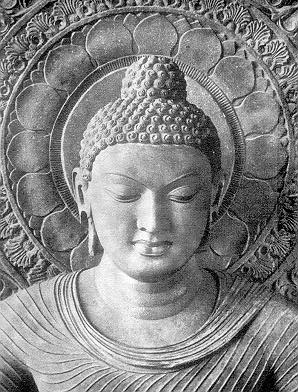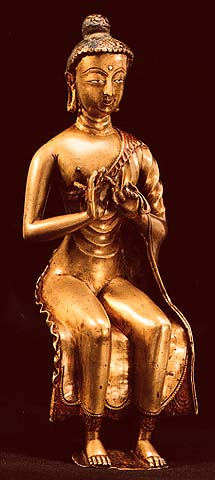|
The Light of Asia
Human Cult ImagesImages of Buddha in human form appeared much later than the construction and worship of stupas and other symbols of the Light of Asia. His magnificent presence was originally indicated by footprints, a standing woman representing his birth, a tree his enlightenment, a wheel his doctrine and first sermon, and the stupa his death or paranirvana. The lack of human cult images until the last centuries Before Chirst was common to all classical Indian religions. Establishing a date and a place of origin for the first images of Gautama Buddha is difficult, but it is generally agreed that it was in the last century BC, about 500 years after his death. The earliest images are either in the Mathura style of Central India, or the Gandhara style of Kushana, what is now Pakistan and Afghanistan.
Gandharan ImageThe Gandharan image showed the Buddha standing or seated, his robes in the Graeco-Roman tradition of drapery in more or less realistic folds. The hair was usually in wavy lines and the Buddha's cranial bump was a bun. Comparisons were often made with the Greek god, Apollo. The statue above definitely illustrates Gandharan influences. Mathuran ImageThe standing Mathura Buddha was thick-set, copying the popular nature spirit of the time, but wearing monastic robes with the right shoulder bare. Another posture is that of the seated yogi with crossed legs (full lotus) and hands laid in the lap, though sometimes, as more common with standing figures, the right hand is raised. The robes, worn over the left shoulder and arm, cover part of the chest and most of the lower part of the body. On the head a twisted coil of hair or bun corresponds to the later cranial bump. Early Mathura Buddhas have been found in Gandhara, while Gandharan influence on Mathura sculpture appears significantly later, so it can be concluded that the first Buddha images were in the Indian Mathura style. Mathura was a trading and Buddhist pilgrimage centre in Uttar Pradesh from the second century BC to the twelfth century AD.
Mondo BoddoA bronze coin from the Kushan era of Kanishka the Great, circa 100 AD, depicts a standing Gandharan style figure with the Bactrian inscription 'Boddo'. This is the earliest datable image of the Buddha, and its use by Kanishka supports scriptural references to his involvement in Buddhism, his erection of several important monuments, and his assembling the fourth council in Kashmir. The naturalistic hairstyle persisted on Gandharan images, whereas Mathura began representing the Buddha with 'snail shell' curls turning to the right. The Mathuran style eventually prevailed ...
Mathuran Snail Shell Curls
Merit MakingThe Gandhara style produced a vast number of images and narrative reliefs between the first and sixth centuries AD. These were initially in stone and later in stucco using moulds to multiply images. Perhaps this later method was employed in the interest of increasing merit. Spiritually Reflective StyleAt Mathura the 'native' Indian style continued to produce sturdy, outward-looking images. Under the Gupta dynasty, 320-550 AD, images were refined to a classical perfection which still reflected the robust qualities of the earlier style. A related school at Sarnath developed a spiritually reflective style with subtle, smooth modelling. This gradually became the most influential model within India and beyond.
Elegant Form and Inner Spirituality
Required MeasurementsThe image of Buddha, who was called The Greatest Yogin of All Times, expresses serene quiescence. The harmony of his physical proportions is the expression of great beauty. The required measurements are laid down in the canon (or standard pattern) of Buddhist art, which corresponds to ideal physical proportions. The span is the basic measure, i.e. the distance from the tip of the middle finger to the tip of the thumb of the outspread hand. This distance corresponds to the space between the dimple in the chin and the hair-line. Each span has twelve finger-breadths. The whole figure measures 108 finger-breadths or 9 spans corresponding to the macro-micro-cosmic harmony measurements. Architecture of the GraveThe perfect proportions of the Buddha’s body corresponds with the design of religious monuments. Its architecture developed from the pre-Buddhist Indian grave-mound. Under these mounds saintly ascetics were buried; their bodies seated on the ground and covered with earth. These dome-shaped graves, or tumuli, of the saints were regarded as holy places, and were destinations for pilgrimage for the devotional and places of practice for meditators. Buried TreasureBuddhism virtually vanished within India following the Muslim invasions of the north in the twelfth century. Fortunately, by that time it had taken root in Central Asia, China, Korea, Japan, and Southeast Asia. During the long period of British colonization, India's largely disused and ruined Buddhist monuments were excavated. By the middle of the twentieth century, a good many Buddhist shrines had been uncovered, restored, and placed under the natural protection of the Archaeological Survey. Among these are a number of India's most world-renowned monuments, such as the great stupa memorial at Sanchi, and the painted monastic halls of Ajanta, visited by pilgrims from around the world and treated in the standard survey texts of world art. Many stone statues of Buddha were also unearthed, and placed in museums around the world. Keeping the FaithThe reuse of Buddhist monuments of the past, with their powerful resonance in panIndian elite and popular culture, has been employed to sanction the new faith by enhancing its identification with established tradition. Beginning in the nineteenth century, British and Indian writers raised a laudatory literary and scholarly appreciation around the rediscovery of India's Buddhist past. The intellectual richness of this tradition and the aesthetic power of its magnificent remains elevated Indian Buddhism in the eyes of the British, and of the outside world, and, consequently, in the eyes of India's modern elite. Buddha, in the words of the English poet, Sir Edwin Arnold, has once more become "the Light of Asia". Shine on, Lord Buddha ...
The Shape of Things to Come
Buddha MaitreyaAbove we have a beautiful image of a Buddha, though neither a past nor present one. It is an image of the Buddha of the future, a messianic Buddha, Buddha Maitreya, who is the one to follow up the historical Buddha Sakyamuni. He waits in the Tushita heaven for the moment he is to appear on earth as the Buddha of the fifth world cycle. At present he is considered one of the dhyani-Bodhisattvas, the creators of the universe. In the future he will be like Sakyamuni, a mortal manusi Buddha who lives on earth for a while in order to teach mankind the doctrine. Kashmir School
Various notes appended and edited
|






